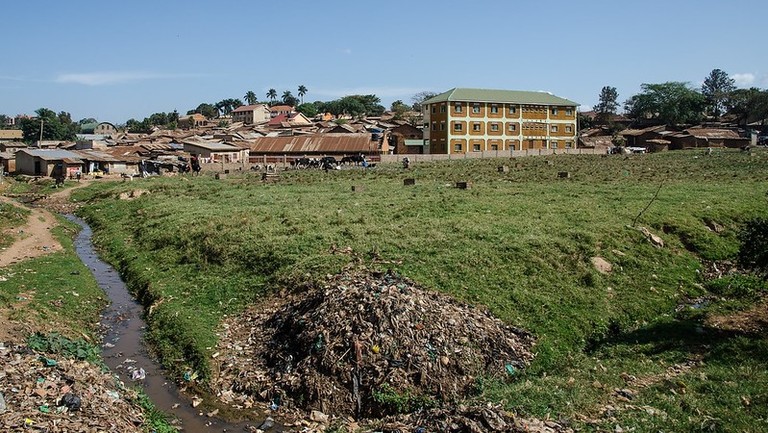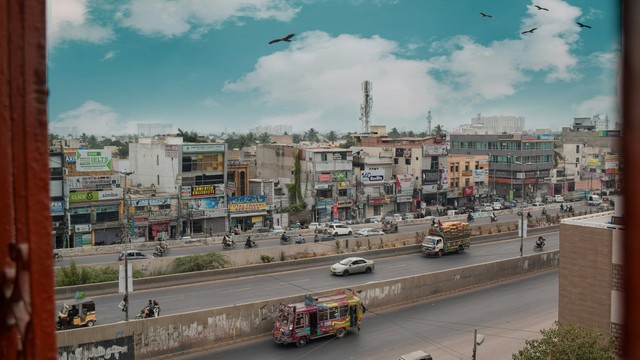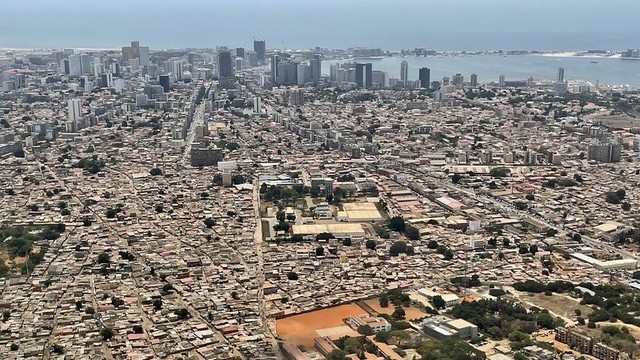Are basic needs given low priority in most bilateral aid programmes? – part one
Is it the case that most bilateral aid programmes give low priority to basic needs such as ‘basic’ education, health, water and sanitation, and (in urban areas) upgrading informal settlements? And if so, why? Especially when these are so important for health, development – and combatting COVID-19.


School grounds in Katwe, a slum in Kampala, Uganda (Photo: Tim Abbott, via Flickr, CC BY-NC-ND 2.0)
For over 40 years now I’ve been looking into donor funding to urban areas in the global South and drawing attention to its problems and inadequacies. The Organisation for Economic Co-operation and Development’s Development Assistance Committee (OECD DAC) collects data on the scale and sectoral priorities of government aid agencies, multilateral agencies and civil society (increasingly important because of the emergence of large, new philanthropic agencies).
I became interested in OECD DAC numbers in the early 1980s. When I visited its statistics division, I was given access to the relevant data files. But because they were using mainframe computers and storage tapes back then, we were unable to access all their data. However, it was clear that these basic needs were given low priority.
Sectoral priorities
The depth, detail and accessibility of the OECD DAC statistics has improved very considerably since then. In reporting on their aid ‘commitments’, the 30-plus DAC nations now have more than 300 different sector codes to choose from.
Commitments are also more broadly divided into just four main sectoral areas and four categories of so-called ‘unallocatable’ areas (see the table below). Overall the latter accounted for about 28% of all aid in 2020, almost half of which is humanitarian aid.
OECD DAC bilateral aid commitments 2020
| Sectors | Commitment (US$ million) | % of total aid |
|---|---|---|
| Social infrastructure and services | 55,461 | 39.6 |
| Economic infrastructure and services | 24,027 | 17.2 |
| Production sectors | 8,777 | 6.3 |
| Multi-sector/cross-cutting | 12,081 | 8.6 |
| Total allocatable | 100,346 | 71.7 |
| Unallocatable | ||
| Commodity aid/General Programme Assistance including household food security | 3,926 | 2.8 |
| Action relating to debt | 983 | 0.7 |
| Humanitarian aid | 16,710 | 11.9 |
| Unallocated/unspecified | 17,917 | 12.8 |
| Total unallocatable | 39,536 | 28.3 |
| TOTAL AID | 139,882 | 100 |
All these sectors contain numerous sub-categories. For instance the largest, ‘social infrastructure and services’, and the most relevant to our concern with basic needs includes education, health, population policies/programmes and reproductive health, and water and sanitation – as well as housing.
Within these sub-categories are further sub-categories. In the case of 'water and sanitation' for instance, these range from funding for simple pit latrines, to large and expensive water treatment plants.
Unpacking priorities and actual commitments
All donor agencies are concerned (to differing degrees) with addressing poverty and meeting basic needs. In recognition of this concern, OECD DAC started distinguishing the categories of ‘basic’ education, health care, water and sanitation, and low-cost housing from the more general sector allocations in its statistics. That said, although there are now codes for basic water and sanitation and for low-cost housing, no actual figures are supplied.
However, we can unpack the commitments to basic education and health, and gain a sense of the actual priority given to these critical areas.
| Basic needs | Commitment (US$ million) | % of sector aid | % of total aid |
|---|---|---|---|
| Basic education | 2,263 | 2.3 | 1.6 |
| Basic health | 9,202 | 9.2 | 6.6 |
| Water and sanitation | 5,515 | 5.5 | 3.9 |
Basic education includes primary education, basic life skills for youth and adults, primary education equivalent for adults, early childhood education and school feeding.
In 2020, it received 2.3% of total commitments to sector allocatable aid in DAC nations – or a paltry 1.6% of total aid commitments. The amounts from different donor countries vary between 1 to 5% of sector (allocatable) aid. Only Luxembourg gives more than 10% (see the chart below for the annual averages from 2011-19). Many of the large bilateral aid programmes, including those from the Netherlands, Sweden, Korea, Spain, Germany, France and Japan, committed less than 2%.
Basic health includes basic health infrastructure, basic nutrition and sanitation, infectious disease control, health education, malaria and TB control, and staff training. It fared better than basic education, receiving 9.2% of sectoral commitments in 2020 (or 6.6% of total aid commitments).
This looks relatively respectable, especially when you consider that basic health allocations do not include some critical categories like reproductive health. But there is something to keep in mind here. This does not necessarily reflect the priority given to basic health by most donor nations.
A few of these bilateral aid programmes (Canada, Ireland and Luxembourg) gave more than 10% of their sector aid to basic health. But around half commit less than 5%, and some less than 3%, including Japan, France, Netherlands and Portugal (see the chart below).
One important difference here is the Bill & Melinda Gates Foundation, which should not be included because it is not a bilateral agency. The foundation provided more than US$1 billion to basic health from 2012-20, and more than $2 billion in 2017, 2019 and 2020.
Although we have no figures for basic water and sanitation, it is possible to consider the more general allocations, which amounted to 5.5% of the total in 2020 (or 3.9% of total aid commitments). In other words, far from lavish funding despite its critical importance.
Luxembourg (again), France and Switzerland are the only countries in the second chart committing more than 10% in this sector. Annual commitments actually went down between 2011 and 2020.
This area is also unusual in that a high proportion of the funding come from loans rather than grants. Basic education is entirely grant funded, basic health 88% grant funded, but water and sanitation receives only 38% as grants.
…and the multilaterals?
There is also the support a bilateral aid programme provides to a multilateral development agency/bank and this may prioritise basic needs. But this is not evident in the OECD DAC statistics.
For multilateral aid, annual commitments averaged $55 billion (2011-19), with only 2.5% to basic education, 8.9% to basic health and 6.1% to water and sanitation.
Some big questions
When we claim that basic needs are a low priority, it raises some very big questions. Relative to what? To need? To share in total funding? To their effectiveness?
But to state the obvious, the low priority to basic needs over the last few decades by most aid agencies and governments is an important factor in their inability to respond far quicker and more effectively to COVID-19.
It's possible that some aid for basic needs is classified under other headings. But this low priority may also be a conscious choice by aid agencies and/or their governments. Or is it because basic needs projects are usually more staff intensive to fund and manage? These and some other possibilities are discussed in my second blog.
Aid agency commitments are likely to show substantial changes in sector priorities in response to COVID-19. But are these seen only as emergency responses or do they provide the chance to address the massive deficits in basic needs provision?
How different the world would be if governments had lived up to their 1970s’ commitments to universal provision of good quality health care, education, and water and sanitation.



